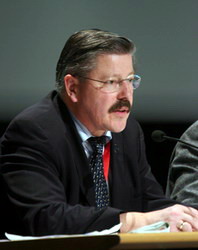 |
A change in mindsets
Technically, renewable energy sources (RES) have the capacity to deliver 100% of the world primary energy demand by 2100. RES also have the obligation to reach this target. RES combined with considerable efforts in energy efficiency are providing the appropriate solution to fight against climate change in a sustainable manner. A 100% of the energy produced from renewables in 2100 means that in 2050, the share should be of 50%. With a target of 20% of RES by 2020, the EU has set an ambitious target. However the EU as well as other industrialized countries (Japan, US) have the obligation to fulfill similar targets in order to make the first steps and show to economies in transition (Brazil, Russia, India or China) that RES can work. To reach these ambitious targets, a change in mindsets has to take place. The ongoing battle of markets versus environment has become obsolete. It is now time to engage the battle for green markets. These could represent a volume of 2.000 billion Euro by 2020 according to some studies ! They forecast that the revenues will surpass those of the automotive and machine-tools industry.
Globally, today 115 000 TWH of primary energy is required to get transformed into secondary form of energy (electricity, fuel, heat, etc.) in order to provide, in a second process, energy to the end-user (light, mobility, air conditioning, power, etc.). Given the important losses in transportation, and transformation only 30% of primary energy is actually being actually used by the end-user. Of the total primary energy, 85% is fossil fuels, 7% is nuclear and 8% RES, (including large hydro). Given current projections, in 2100 it is expected that primary energy needs could reach 600 000 TWh if we remain with the current energy mix. In 2100, if energy needs is entirely provided by RES instead of exhaustible energies and if strong energy efficiency measures are adopted in end-user applications, primary energy will be equal to secondary energy and thus will be almost entirely consumed by the end-user. Primary energy needs could therefore be reduced to 150 000 TWh (instead of 600 000 TWh).
Three main renewable energy technologies have the potential to reach this target:
- Wind energy, as today’s biggest contributor after hydro,
- Solar Thermal Concentrator, as tomorrow’s big contributor for centralized electricity production at places with high direct solar radiation
- PV solar electricity as tomorrow’s big contributor for decentralized electricity supply everywhere.
Competitiveness is the answer
Today RES are more expensive than conventional energy sources and PV in a higher extent depending on the amount of solar radiations available. However, PV will be competitive in 2020 in the sunniest regions. Rapid technology development accompanied by mass production are the key factors which will permit to catch up with conventional energy sources and reach competitiveness. Photovoltaic technology in its production process is comparable to the production of LCD screens and so is the capacity of cost reduction
The future Framework Directive on Renewable Energies
In the last European spring summit, Heads of States agreed on a binding overall target of 20% from RES by 2020 and a 10% minimum binding target for biofuels
To reach this objective, Member States have to set national targets and action plans on:
- RES-electricity
- Heating and cooling
- Transport
The European Commission will propose in the autumn 2007 a new Framework Directive covering all RES sectors (electricity, heating/cooling & transport). The European renewable energy industry is asking that:
- National Action Plans include sector specific targets for RES-Electricity, RES heating & cooling and transport.
- National Action Plans should ensure the development of ALL renewable energy technologies.
There is a tendency to speak about burden sharing among Members States, whether it should be taken as an opportunity sharing.
Concerning each sector, the future Framework Directive must:
- For electricity, take the existing RES-E Directive (EC/2001/77) as the minimum starting point, include provisions on grid-access issues. Existing provisions on administration procedures should at least be maintained or strengthened.
- For heating & cooling a proper definition should be included together with a removal of barriers and reliable statistics
- For transport a definition of sustainability standards of biofuels is a key priority.
Finally, we know that decision process can be long, however the ending of the current RES-electricity and Biofuels directives are expected to be in 2010. That is why the new legislation should be in place no later than this date.
To subscribe or visit go to: http://www.epia.org/09newsletter/newsletter_new.asp